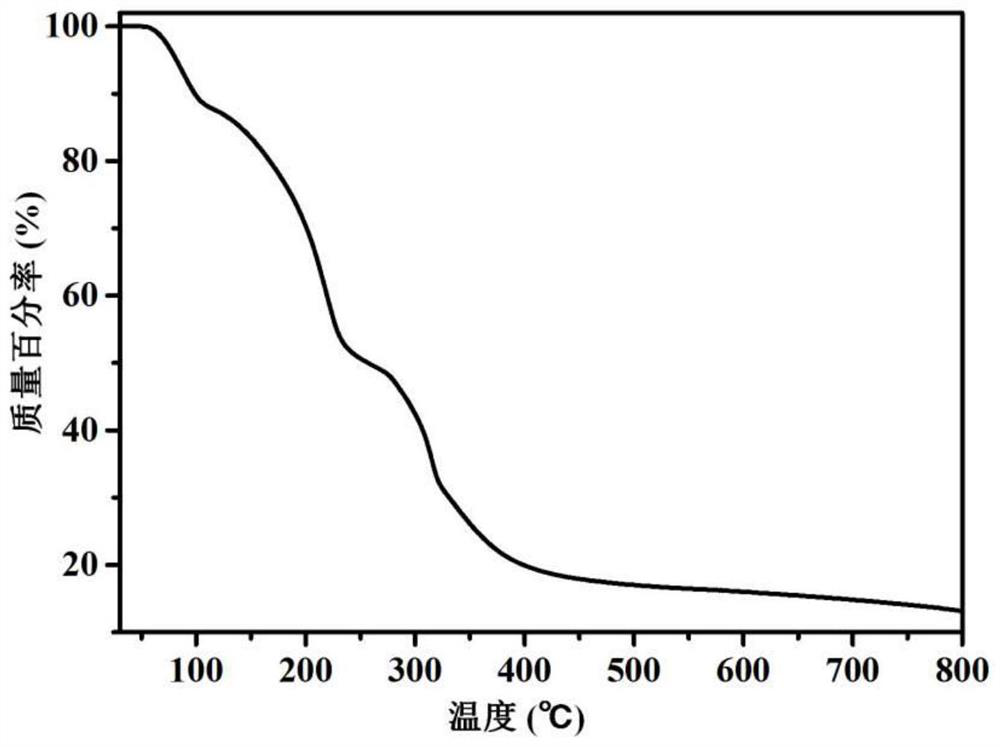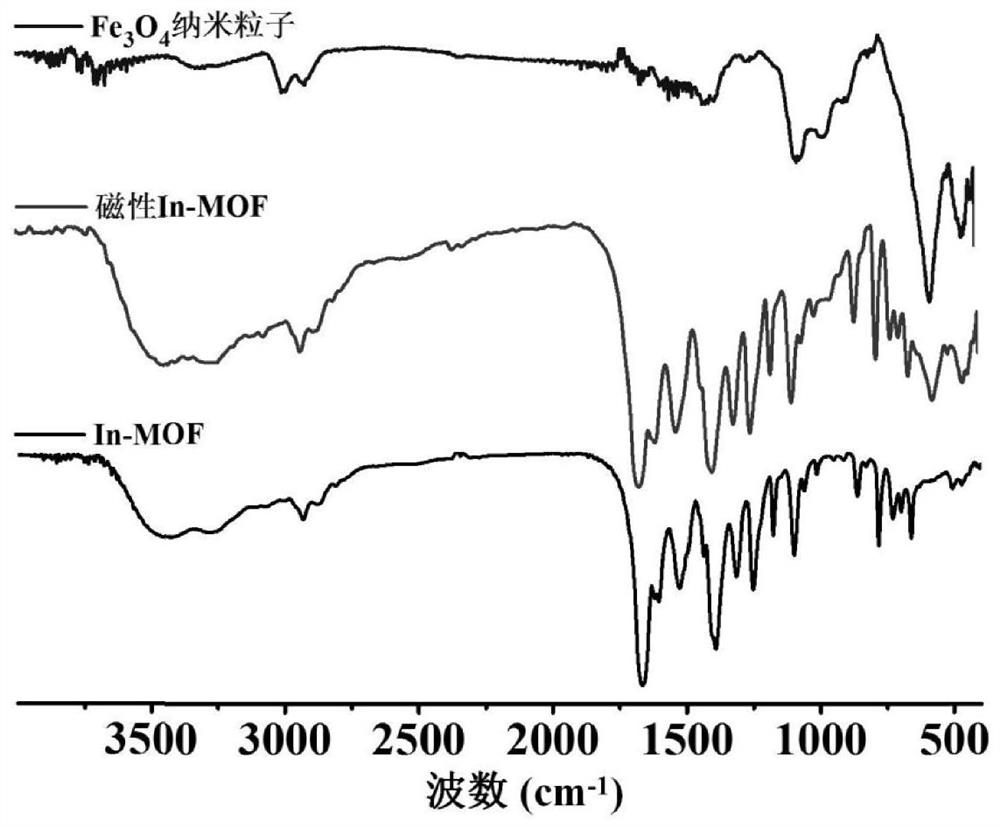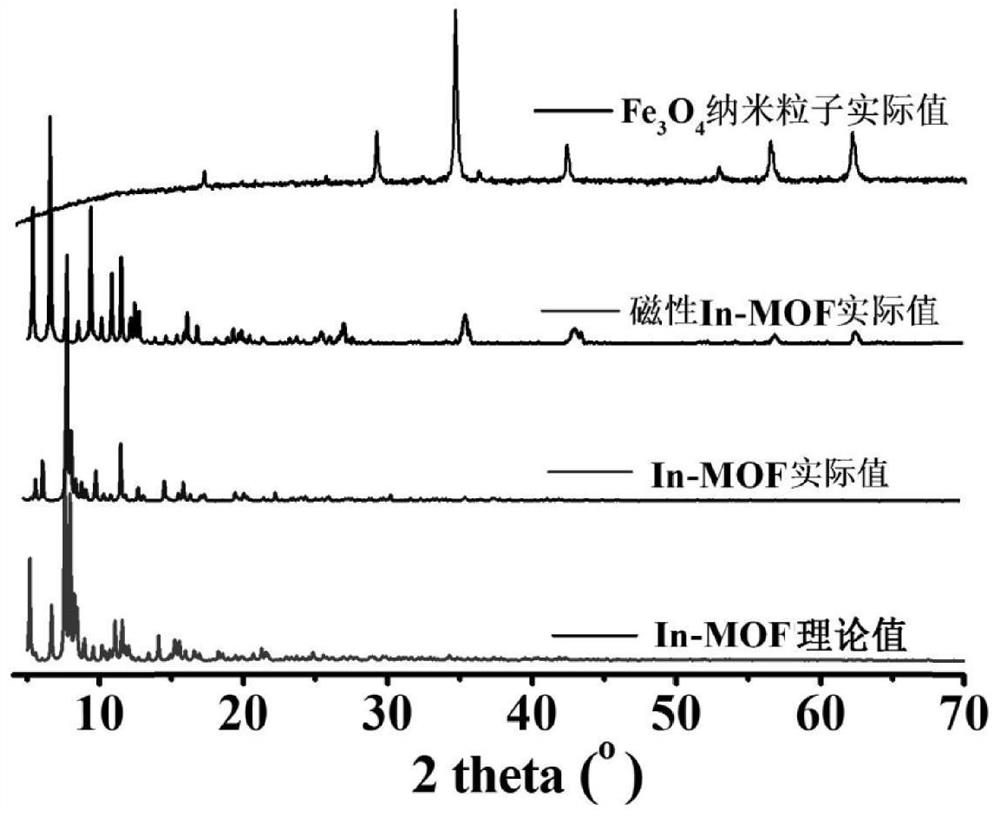Preparation method and application of magnetic In-MOF-based photocatalyst
A photocatalyst and magnetic technology, applied in the field of photocatalytic materials, can solve the problems of low photocurrent quantum yield, overflow of heavy metal ions, and reduced efficiency, and achieve the effects of easy recovery, no secondary pollution, and good thermal stability.
- Summary
- Abstract
- Description
- Claims
- Application Information
AI Technical Summary
Problems solved by technology
Method used
Image
Examples
preparation example Construction
[0037] triangular organic ligand H 3The preparation method of L(4,4',4"-[trimesyltri(carbonylbenzene)]-3,3',3"-trimethyl-tribenzoic acid) specifically follows the steps below:
[0038] Step a, dissolving 4-amino-2-methylbenzoic acid in DMF, and continuously magnetic stirring in an ice-water bath until completely dissolved to obtain a mixed solution;
[0039] Every 1mol of 4-amino-2-methylbenzoic acid corresponds to 65mL of DMF;
[0040] Step b, dissolve trimesoyl chloride in DMF, stir until dissolved, and slowly add dropwise to the mixture in step a within 15 minutes, then add triethylamine dropwise within 10 minutes, react in an ice-water bath for 3 hours, and then React at room temperature for 24h to obtain a reaction solution;
[0041] Every 1mol of trimesoyl chloride corresponds to 100mL of DMF and 0.36mol of triethylamine
[0042] Step c, adding distilled water to the reaction solution under continuous magnetic stirring, and removing DMF and distilled water with a Buch...
Embodiment 1
[0054] The organic ligand H 3 L (0.04mmol, 24.44mg), In(NO 3 ) 2 ·3H 2 O (0.08mmol, 25.51mg), hexamethylenetetramine (0.008mmol, 1.12mg) and 0.04mmol (9.26mg) Fe 3 o 4 , mixed in 10.0 mL of N,N-dimethylformamide, added dropwise concentrated nitric acid solution with a mass fraction of 65%, adjusted the pH of the reaction system to 5.0, and sealed it into a 25 mL small glass bottle. The solvothermal reaction was carried out at 110 °C for 80 hours, and then naturally cooled to room temperature to obtain the magnetic In-MOF-based photocatalyst.
[0055] figure 1 is the thermogravimetric curve of the prepared magnetic In-MOF-based photocatalyst, figure 1 The thermogravimetric curves showed that the magnetic In-MOF-based photocatalyst experienced three main weight loss stages in the range of 30-800 °C under flowing nitrogen at a temperature increase of 10 °C / min. The weight loss rate of about 11.87% between 30-106 °C should come from the departure of water molecules and air ...
Embodiment 2
[0065] The preparation method of a kind of magnetic In-MOF based photocatalyst of the present invention is specifically:
[0066] Under closed conditions, indium nitrate trihydrate In(NO 3 ) 2 ·3H 2 O, organic ligand H 3 L.Fe 3 o 4 Magnetic nanoparticles and template agent hexamethylenetetramine were dissolved in N,N-dimethylformamide solution and continuously stirred, and concentrated nitric acid solution was added dropwise to adjust the pH of the reaction system to 4.0, and the reaction was performed under solvothermal conditions. Obtain the above-mentioned magnetic In-MOF-based photocatalyst;
[0067] The solvothermal reaction temperature is 110°C, and the required reaction time is 72 hours;
[0068] Indium nitrate trihydrate, organic ligand H 3 L, hexamethylenetetramine, Fe 3 o 4 The molar ratio of nanoparticles and N,N-dimethylformamide is 2:1:0.2:1:500; the mass fraction of concentrated nitric acid solution is 65%;
[0069] triangular organic ligand H 3 The pr...
PUM
 Login to View More
Login to View More Abstract
Description
Claims
Application Information
 Login to View More
Login to View More - R&D
- Intellectual Property
- Life Sciences
- Materials
- Tech Scout
- Unparalleled Data Quality
- Higher Quality Content
- 60% Fewer Hallucinations
Browse by: Latest US Patents, China's latest patents, Technical Efficacy Thesaurus, Application Domain, Technology Topic, Popular Technical Reports.
© 2025 PatSnap. All rights reserved.Legal|Privacy policy|Modern Slavery Act Transparency Statement|Sitemap|About US| Contact US: help@patsnap.com



